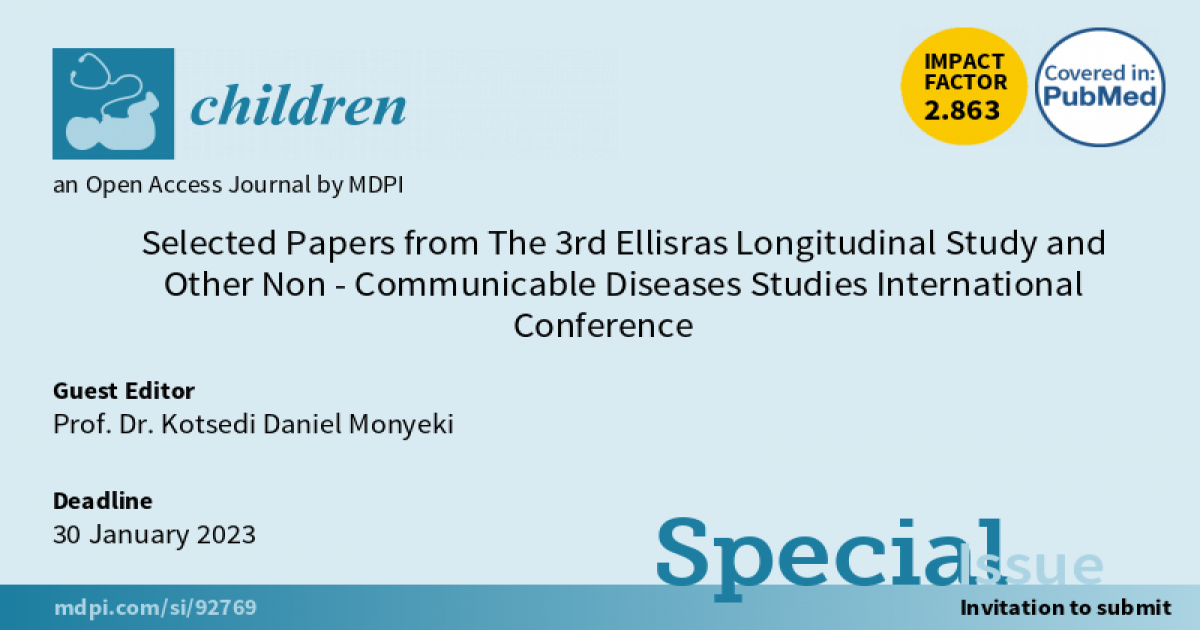Selected Papers from the 3rd Ellisras Longitudinal Study and Other Non-communicable Diseases Studies International Conference
A special issue of Children (ISSN 2227-9067). This special issue belongs to the section "Global and Public Health".
Deadline for manuscript submissions: closed (30 June 2023) | Viewed by 19049

Special Issue Editor
Interests: smoking; longitudinal studies; physical activity; alcohol; physical finess; diabetic; dietary intake; hypertension; metabolic syndrome; anthropometric measurements; socio-economic status; body composition; none communicable diseases
Special Issues, Collections and Topics in MDPI journals
Special Issue Information
The Ellisras Longitudinal Study and other Non-Communicable Disease Studies International Conference organizing committee takes pleasure in inviting you to the 3rd International Conference on non-communicable diseases on 22–24 November 2022 at the University of Limpopo, Lephalale (Ellisras), Bangalong Village/School, South Africa. The major subthemes of the conference include: 1) lifestyle risk factors for non-communicable disease—tobacco and alcohol consumption, nutrition and dietary intake, and physical activity; 2) biological risk factors for non-communicable diseases—hypertension, genetics, lipids profile, dysglycemia; 3) growth, maturation, and aging; 4) child health and health education; 5) impact of COVID-19 on CVDs and other NCDs; and 6) poverty, NCDs/CVDs, and COVID-19 linkages. The 3rd ELSONCDIC will provide a unique, inclusive platform for discussion by ordinary members of the Ellisras community, expert scholars, students, and experienced professionals from all over the world, offering a truly special international networking experience,—a comprehensive and interactive program in which participants can cultivate their cross-cultural and communication skills while shining a light on different topics related to poverty, COVID-19, and NCDs, to allow the program to have a long-lasting effect on the conference participants as well as the Ellisras/Lephalale communities, as the knowledge gained will be taken back to our respective communities and families.
Keynote/preliminary speakers for the conference include 1) Prof. André Pascal Kengne—Non-Communicable Diseases Research Unit South African Medical Research Council, Cape Town (Medical practitioner and Cardiologist); 2) Prof. Shisana Baloyi, Academic Head of Obstetrics and Gynaecology from Health Sciences Department, University of the Free State (Medical practitioner and Gynecologist); 3) Prof. dr. Tebogo Mothiba, Executive Dean, Faculty of Health Science, University of Limpopo, South Africa; 4) Prof. Muzi Maseko, School of Physiology, University of the Witwatersrand, Johannesburg, South Africa; 5) Prof. Lloyd Leach Department of Sport, Recréation and Exersice Science, University of the Western Cape; and 6) Prof. Benedicta Ngwenchi Nkeh-Chungag Physiology, Walter Sisulu University, Umtata; 6) Prof. Han Kemper, Emeritus Professor, VU University Medical Center, Amsterdam, The Netherlands; 7) Dr. Geofrey Musinguzi, Department of Primary and Interdisciplinary Care, University of Antwerp, Belgium and Department of Disease Control and Environmental Health, School of Public Health, Makerere University, Uganda. Dr Johanna Mathupa Mogane (Medical Practitioner, George Mokhari Hospital, Pretoria).
Papers presented at the 3rd Ellisras Longitudinal Study and other Non-Communicable Diseases Studies International Conference will undergo vigorous peer review for publication consideration in the Children (MDPI) journal. Delegates will be required to submit papers of between 4000 and 5000 words. The paper layout should follow the guidelines and reference style of the Children (MDPI) journal. Full-length articles should be submitted on or before 30 January 2023. Please note only papers that fit the scope of the Children journal will be considered for publication.
Delegates are requested to register and submit their abstract online on the conference website link: https://www.ul.ac.za/elsconf2022/ on or before the 15 June 2022.Prof. Dr. Kotsedi Daniel Monyeki
Guest Editor
Manuscript Submission Information
Manuscripts should be submitted online at www.mdpi.com by registering and logging in to this website. Once you are registered, click here to go to the submission form. Manuscripts can be submitted until the deadline. All submissions that pass pre-check are peer-reviewed. Accepted papers will be published continuously in the journal (as soon as accepted) and will be listed together on the special issue website. Research articles, review articles as well as short communications are invited. For planned papers, a title and short abstract (about 100 words) can be sent to the Editorial Office for announcement on this website.
Submitted manuscripts should not have been published previously, nor be under consideration for publication elsewhere (except conference proceedings papers). All manuscripts are thoroughly refereed through a single-blind peer-review process. A guide for authors and other relevant information for submission of manuscripts is available on the Instructions for Authors page. Children is an international peer-reviewed open access monthly journal published by MDPI.
Please visit the Instructions for Authors page before submitting a manuscript. The Article Processing Charge (APC) for publication in this open access journal is 2400 CHF (Swiss Francs). Submitted papers should be well formatted and use good English. Authors may use MDPI's English editing service prior to publication or during author revisions.
Keywords
- non-communicable diseases
- child health
- lifestyle factors
- tobacco and alcohol consumption
- cardiovascular diseases
- growth
- genetics
- maturation
- physical activity
- lipids
- poverty, NCDs/CVDs, and COVID-19






